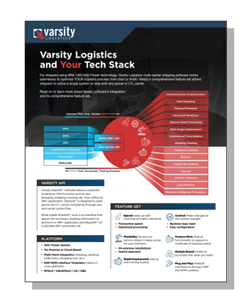
Enhancing Supply Chain Visibility: The Vital Role of Real-Time Parcel Tracking for IBM i Shippers
Discover how leading shipping solutions and automated real-time tracking provide exceptional customer experiences
If you asked a group of people to describe in one word how they would feel if they were unable to track their package, it’s likely some possible responses would be: anxious, frustrated, stressed, impatient, uncertain, nervous, and inconvenienced. Collectively, each of these responses are negative experiences for the customer; something that any business wants to avoid.
In the world of modern commerce, the ability to track and manage shipments in real-time isn’t just desirable; it’s essential. This is especially true with the immense growth e-commerce has experienced in recent years, where customers now expect full transparency and control over their orders. In fact, a recent study showed that 96% of customers track their orders, and 43% track them daily.
Not only does the ability to track and trace your package in real-time bring consumers a sense of security and control, but it also introduces an element of excitement. The journey from “add to cart” to package delivery is more than just transactional – it’s experiential. The anticipation of a long-awaited package, waiting for the chance to open it up, and the satisfaction of knowing the exact moment of arrival are all part of the consumer journey.
Need for Automated Shipment Tracking Solutions
Imagine ordering a sentimental gift for a loved one, only to be left in the dark about its whereabouts. Or what if you order essential items for an urgent situation, such as medication, not knowing if they will arrive on time. Instant gratification has become a norm in today’s world, so delays and uncertainties can tarnish consumer experiences very quickly. This makes real-time order tracking and tracing a crucial capability for shippers.
Businesses that prioritize transparency and communication throughout the shipping process are more likely to maintain their competitiveness, keep their customers happy, and grow their brand awareness. However, those who fail to adapt to this imperative need put themselves at risk of losing customers and revenue.
Keeping up with the ever-evolving needs of consumers can present a myriad of supply chain challenges, threatening to impede efficiency and profitability. And standing at the top of these challenges is reliance on outdated technology and manual processes, showing the need for automated tracking solutions. For parcel shippers on IBM i (AS/400) Power systems, the lack of automated tracking solutions can lead to several pain points including:
- Risk of Errors: It’s no surprise that any sort of manual task is at risk of human error. Manual errors in data entry and communication processes can cause discrepancies in shipment information, leading to potential shipment delays.
- Inefficient Resource Allocation: Manual tracking and tracing methods are time-consuming and require heavy attention to detail, leading to inefficient resource allocation and increased labor costs.
- Limited Visibility: The lack of real-time tracking limits supply chain visibility, making it a challenge to identify bottlenecks or areas for optimization.
- Delayed Deliveries: Without real-time tracking, shippers often struggle to identify transit delays. This can lead to missed delivery deadlines and unsatisfied customers.
- Increased Customer Inquiries: If customers are unable to track their orders in real-time, customer service teams are swarmed with where is my order (WISMO) inquiries. This can strain resources and lead to dissatisfied customers.
Now that customer expectations for transparency and control are at an all-time high, the importance of real-time shipment tracking solutions cannot be overstated. Customers expect their deliveries to be on time and visibility into the status of their shipments at every stage of the delivery process. To do so, shippers must leverage technology to streamline their operations, enhance visibility, and maintain competitiveness.
The good news for IBM i (AS/400) Power systems shippers is that there are advanced automated software solutions available, like Varsity Logistics’ ShipTalk Parcel module, empowering shippers with the visibility and control they need to navigate the complexities of parcel shipping.
Introducing Modern Shipping Transparency with ShipTalk
ShipTalk is a revolutionary solution enabling businesses access to real-time delivery status and online tracking. This module is a part of Varsity Logistics’ comprehensive supply chain suite for users. When paired with Varsity’s industry-leading multi-carrier shipping software, ShipSoft-Parcel, it works to help parcel shippers overcome the challenges of modern shipping with ease and confidence.
How ShipTalk Works
ShipTalk empowers shippers with the resources they need to streamline operations, enhance visibility, and deliver exceptional customer experiences. ShipTalk is more than just a tracking solution; at its core, it’s a connectivity suite that expands visibility and communication between shippers and their supply chain partners. By extending shipment control beyond the warehouse, it enables enhanced collaboration with carriers and consignees, facilitating real-time status updates, automated export filing, and enriched communication functionalities.
Customers can select from several of ShipTalk’s connectivity tools to meet their unique needs, including:
- UPS Online Tracking
- UPS Trace Request
- FedEx Tracking
- USPS Delivery Confirmation
- Alerts (non-carrier specific)
- AES (Automated Export System)
Key Benefits of ShipTalk
The ShipTalk Parcel module offers several key benefits to IBM i (AS/400) Power systems shippers seeking to transform their shipping operations, overcome parcel challenges, and achieve greater success in today’s dynamic shipping landscape.
- Real-time Shipment Visibility: One of the primary benefits of ShipTalk is the ability to provide up-to-the-minute order status updates on the whereabouts of shipments. By leveraging electronic links with third-party carriers, ShipTalk offers shippers unparalleled visibility into the movement of their parcels, enabling them to identify potential delays, take proactive measures to ensure on-time delivery, and provide great customer service.
- Enhanced Supply Chain Relationships: ShipTalk fosters stronger relationships with supply chain partners through enhanced communication capabilities. By facilitating real-time communication and collaboration between shippers, carriers, and consignees, ShipTalk strengthens trust and transparency throughout the supply chain ecosystem. This improved communication leads to smoother operations, fewer misunderstandings, and ultimately, more productive partnerships.
- Reduced Expenses: Because ShipTalk automates several key supply chain processes, it significantly reduces manual labor expenses. Manual tasks like data entry, document handling, and partner communication are effortlessly facilitated through ShipTalk’s automation capabilities. With minimal need for human intervention, ShipTalk reduces labor costs, avoids costly errors, increases operational efficiency, and ultimately improves the bottom line.
- ShipTalk Alerts: For shippers seeking a proactive approach to supply chain management, ShipTalk sends advance shipment notifications to supply chain partners prior to delivery. Through email alerts, shippers can promptly inform recipients about upcoming shipments at any time through the shipping process, providing them with important information like tracking numbers and delivery specifics. This proactive communication not only improves coordination but also helps recipients prepare for incoming shipments, reducing potential delays and enhancing the customer experience.
Enhance Supply Chain Visibility with ShipTalk and Varsity Logistics
Varsity Logistics, provider of top-tier multi-carrier shipping software for parcel execution, stands as the only holistic shipping solution built for the IBM i. In addition to the key capabilities provided by the ShipTalk module, Varsity’s ShipSoft-Parcel suite offers several other revolutionary modules, equipping shippers with the tools to navigate parcel shipping challenges, including:
Varsity Logistics also offers multi-carrier shipping software for Less-Than-Truckload (LTL) shippers with additional freight supply chain execution modules and multi-modal capabilities.
The modern logistics world demands automated solutions and capabilities that can meet the evolving expectations of our consumers. That is why Varsity Logistics plays a powerful force in supply chain management, offering comprehensive solutions that empower shippers to tackle even the most complex parcel shipping challenges. By leveraging ShipTalk’s automated functionalities, shippers can alleviate the pitfalls of manual tasks, provide full order transparency to their customers, and set themselves up for long-term success.
Looking for a way to provide the ultimate customer experience with automated real-time shipment tracking? To learn more about ShipTalk for parcel or Varsity Logistics’ other parcel or LTL shipping software solutions, contact our team of shipping experts or schedule a demo. Elevating your IBM i shipping strategy starts here.











